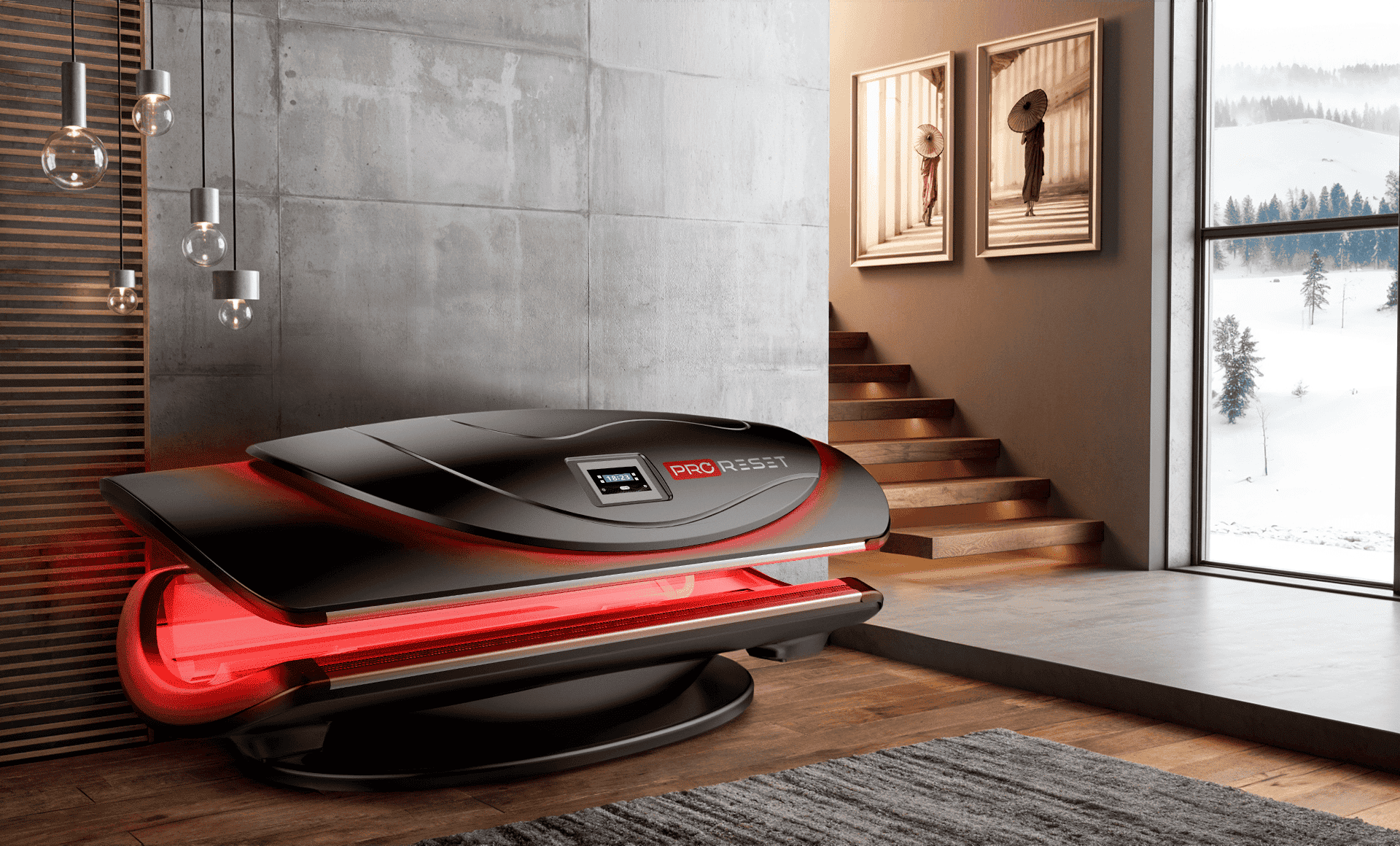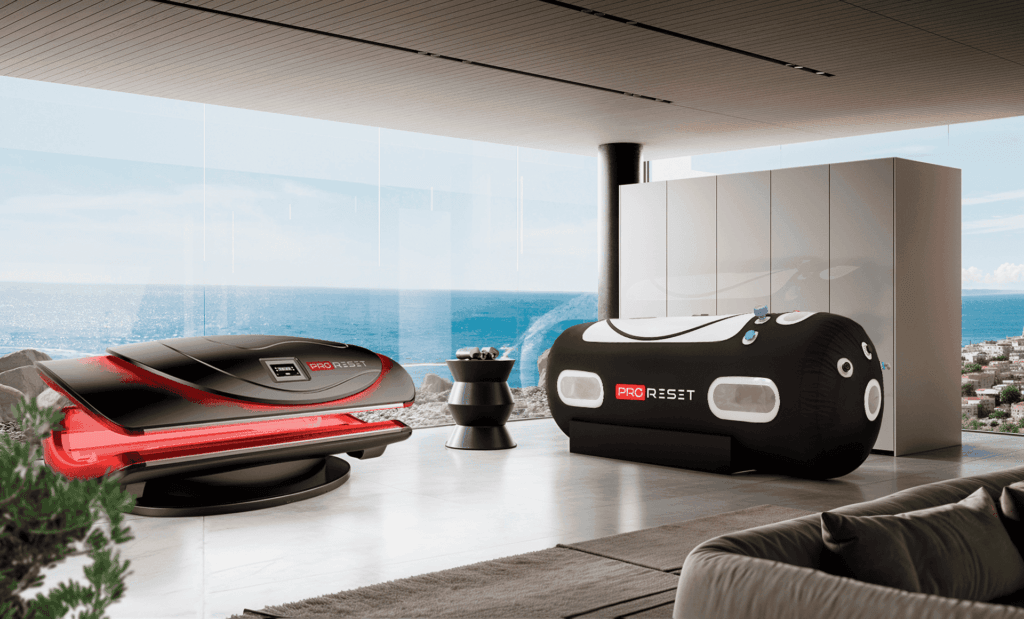ProReset's Wellness Technologies
What is hyperbaric oxygen therapy (hbot)?
Hyperbaric Oxygen Therapy (HBOT) involves placing an individual inside a chamber where the atmospheric pressure is increased above normal levels while breathing oxygen. Studies have suggested that this process enhances oxygen absorption in the blood plasma, allowing oxygen to reach tissues with restricted blood flow. Research suggests that this may contribute to various physiological responses, including:
- Supporting natural recovery processes, which could aid in post-exercise muscle repair and recovery.
- Enhancing circulation and oxygenation, which has been linked to various metabolic and cellular functions.
- Modulating inflammatory responses, as some studies indicate a potential role in balancing pro- and anti-inflammatory markers.
- Triggering the Hyperoxic-Hypoxic Paradox, a phenomenon observed in some research that may contribute to cellular adaptations and resilience.
Matrix Video
What are some common uses of Hyperbaric Oxygen Therapy?
While HBOT has been used in 15 FDA approved medical settings for conditions like decompression sickness and carbon monoxide poisoning, severe infections, including those caused by mold, non-healing wounds, such as diabetic foot ulcers, radiation injuries, arterial gas embolism, gangrene, crush injuries, it has also gained interest in wellness, sports recovery, and longevity applications. Some studies have suggested potential benefits and some promising outcomes have been reported across a variety of groups including: neurological conditions, traumatic brain injury (TBI), stoke, neurodevelopmental disorders like cerebral palsy, alzheimer dementia, chronic wounds, autism spectrum disorder (ASD), chronic pain management, fibromyalgia, sports injuries and sports recovery, anti-aging and longevity, mental health, depression, anxiety, post-traumatic stress disorder (PTSD), radiation-induced tissue damage and the likes of:
- Athletic recovery – Research indicates that HBOT may support muscle recovery following intense training.
- General wellness & vitality – Some reports suggest HBOT may contribute to improved energy levels.
- Anti-aging research – Some studies explore potential links between HBOT and cellular health.
Cognitive function – Some research suggests HBOT may influence brain oxygenation, potentially impacting focus and clarity.
What types of hyperbaric oxygen chambers does ProReset offer?
Hyperbaric oxygen chambers come in different types, each designed to serve specific therapeutic needs and environments whether in the comfort of your home or in wellness, physiotherapy and medical clinics or spa’s and hospitals. At ProReset, we offer one of the largest lineups of hyperbaric chamber systems. As a brief summary, the types of chamber systems we offer include, but are not limited to:
- Wellness and medical chambers.
- Reclining, siting and horizontal lay-down versions.
- Soft-shelled portable chambers made from TPU or polyurethane as well as hard-shelled chambers made from aluminum or steel.
- Mono-place chambers for a single user or multi-place chambers for 2-18 people.
- Depending on the model and requirements, chambers can come with free flow oxygen and/or with a built-in breathing system (BIBS).
- Turn-key systems typically include 10-20 Lpm oxygen concentrator(s) and chillers.
- Veterinary Hyperbaric Chambers designed to accommodate animals such as dogs, cats & horses.
To make proper recommendations, we need to perfectly understand your individual requirements. Contact us today to discuss your hyperbaric project with our experienced hyperbaric advisors.
Please feel free to review more FAQ here.
Scientific Studies Supporting HBOT
Numerous studies have validated the effectiveness of HBOT in various medical fields:
Study: Hyperbaric oxygen therapy increases telomere length and decreases immunosenescence in isolated blood cells: a prospective trial
Authors: Yafit Hachmo, Amir Hadanny, Ramzia Abu Hamed, Malka Daniel-Kotovsky, Merav Catalogna, Gregory Fishlev, Erez Lang, Nir Polak, Keren Doenyas, Mony Friedman, Yonatan Zemel, Yair Bechor, Shai Efrati
Journal: Aging (Albany NY)
Summary: This prospective trial investigated the effects of hyperbaric oxygen therapy (HBOT) on telomere length and immunosenescence in isolated blood cells. The study found that HBOT can increase telomere length and reduce markers of immunosenescence, suggesting potential anti-aging benefits.
Study: Hyperbaric oxygen as an adjuvant for athletes
Authors: Yoshimasa Ishii, Masataka Deie, Nobuo Adachi, Yuji Yasunaga, Patrick Sharman, Yutaka Miyanaga, Mitsuo Ochi
Journal: Sports Medicine
Summary: This review examines the use of hyperbaric oxygen therapy (HBOT) as an adjunctive treatment for athletes. It discusses the potential benefits of HBOT in enhancing recovery from injuries and improving performance, while also addressing the limitations and need for further research in this area.
Study: Hyperbaric oxygen therapy improves neurocognitive functions and symptoms of post-COVID condition: randomized controlled trial
Authors: Shani Zilberman-Itskovich, Merav Catalogna, Efrat Sasson, Karin Elman-Shina, Amir Hadanny, Erez Lang, Shachar Finci, Nir Polak, Gregory Fishlev, Calanit Korin, Ran Shorer, Yoav Parag, Marina Sova, Shai Efrati
Journal: Scientific Reports
Summary: This randomized controlled trial evaluated the efficacy of hyperbaric oxygen therapy (HBOT) in improving neurocognitive functions and alleviating symptoms in individuals with post-COVID condition. The findings suggest that HBOT can lead to significant improvements in cognitive function and reduction in post-COVID symptoms, offering a potential therapeutic option for affected patients.
For more details, these studies can be accessed through medical databases like pubmed.
Red Light Therapy
Red light therapy is a simple, non-invasive treatment that shines red and near infrared light on a person’s skin and reaches the cells. red light therapy involves using low-wavelength red light to promote healing and rejuvenation in the body.

ProReset AuraLight
How Does Red Light Therapy Work?
Led light therapy stimulates cellular activity by boosting atp (adenosine triphosphate) production in the mitochondria, enhancing energy levels and supporting the body’s natural healing process. Various wavelengths, especially in the red and infrared spectrum, penetrate the skin to activate biological responses such as increased blood circulation and pain relief.
What are primary benefits of Red Light Therapy?
- Pain relief: red light therapy helps reduce pain and inflammation, making it effective for conditions like arthritis, nerve pain, musculoskeletal pain, and chronic pain disorders.
- Enhanced skin health: by boosting collagen production and improving skin elasticity, red light therapy minimizes signs of aging, such as wrinkles, fine lines, and acne.
- Faster wound healing: this therapy accelerates tissue repair, making it beneficial for treating injuries and promoting faster recovery.
- Anti-inflammatory benefits: red light therapy helps reduce inflammation, providing relief for conditions like carpal tunnel syndrome and other chronic pain issues.
- Improved joint and muscle function: supporting joint and muscle health, red light therapy is ideal for athletes and individuals seeking faster recovery and enhanced overall wellness.
- Mental well-being: by stimulating the release of endorphins, red light therapy naturally aids in pain relief and contributes to improved mental health.
Please feel free to review more FAQ here.

Scientific Studies Supporting Red Light Therapy
Numerous studies have validated the effectiveness of red light therapy in various medical fields:
Study: Pulsed Transcranial Red/Near-Infrared Light Therapy Using Light-Emitting Diodes Improves Cerebral Blood Flow and Cognitive Function in Veterans with Chronic Traumatic Brain Injury: A Case Series
Authors:Hipskind SG, Grover FL Jr, Fort TR, et al.
Journal:Photomedicine and Laser Surgery, 2018.
Summary: This case series investigated the effects of pulsed transcranial photobiomodulation therapy (tPBMT) using light-emitting diodes (LEDs) on veterans with chronic traumatic brain injury (TBI). The findings suggest that pulsed tPBMT may improve cognitive function and regional cerebral blood flow (rCBF) in individuals several years post-TBI. The authors recommend larger, controlled studies to further evaluate these preliminary results.
Study: Photobiomodulation in Human Muscle Tissue: An Advantage in Sports Performance?
Authors: Ferraresi C, Huang YY, Hamblin MR.
Journal:Journal of Biophotonics, 2016.
Summary: This systematic review analyzed 46 studies involving 1,045 participants to assess the effects of photobiomodulation (PBM) on human muscle tissue. The results indicate that PBM can enhance muscle mass gain after training and reduce inflammation and oxidative stress in muscle biopsies. Various devices, including single laser probes, clusters of laser diodes, LED clusters, and mixed clusters, were utilized, emitting red, near-infrared (NIR), or combinations of both wavelengths.
Study: Acute Low Back Pain with Radiculopathy: A Double-Blind, Randomized, Placebo-Controlled Study
Authors: Konstantinovic LM, Kanjuh ZM, Milovanovic AN, et al.
Journal: Photomedicine and Laser Surgery, 2010.
Summary: This double-blind, randomized, placebo-controlled study evaluated the clinical effects of low-level laser therapy (LLLT) in patients with acute low back pain (LBP) accompanied by radiculopathy. The study aimed to determine the efficacy of LLLT in reducing pain and disability associated with acute LBP and radiculopathy, conditions often linked to inflammation.
For more details, these studies can be accessed through medical databases like pubmed.